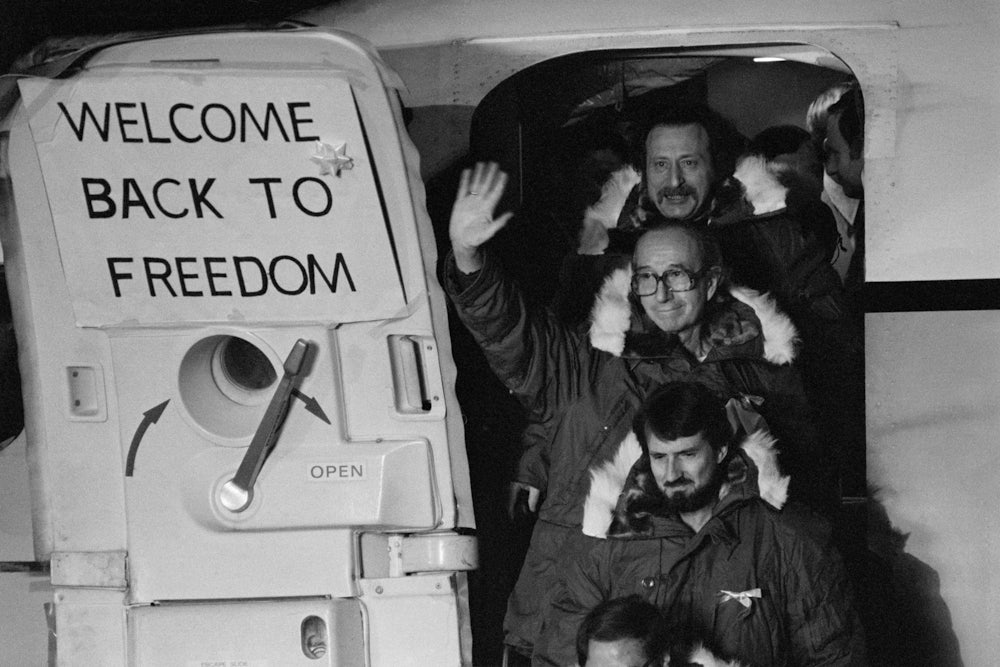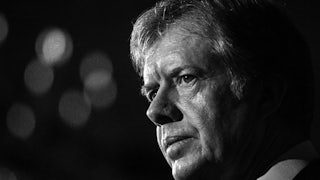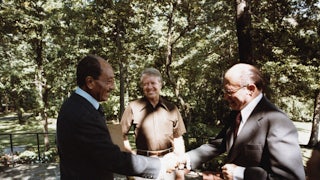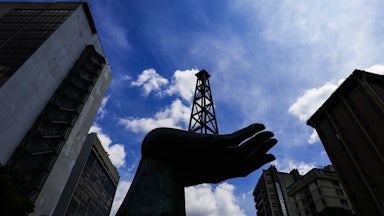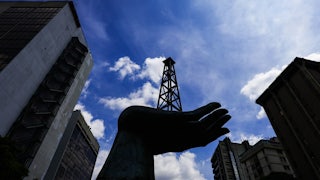Forty-three years after the climactic events of 1980, the four of us—all steeped in the history of the Carter administration—believe that it’s time to move past conspiracy theories to hard historical conclusions about the so-called October Surprise. We think there’s now enough evidence to say definitively that Ronald Reagan’s campaign manager, the late William Casey, ran a multipronged covert operation to manipulate the 1980 presidential election—and that these acts of betrayal might have affected the outcome.
In April, the four of us interviewed Stuart Spencer, who was a chief strategist and architect of Reagan’s 1980 general election campaign. He said that he believed then—and now—that Carter might have won if the American hostages seized at the U.S. Embassy in Tehran in 1979 had been released before the 1980 election.
But Bill Casey was determined not to let that happen. In March, The New York Times confirmed a long-ignored story that in the summer of 1980, Casey persuaded former Texas Governor John Connally to embark on a secret mission to the Middle East, where Connally and his associate, Ben Barnes, asked various Arab leaders to urge the Iranians not to release the 52 hostages. This firsthand account was only the latest evidence that Casey, at a minimum, attempted to prolong their captivity in order to help his candidate win.
Casey, an OSS spymaster for the Allies during World War II, would later become Reagan’s CIA director. In the summer of 1980, he established a secret network of more than 100 current and former diplomats, military officers, and CIA assets to monitor diplomatic channels and military bases, ostensibly to give the Reagan campaign time to spin the news of what Casey dubbed Carter’s potential “October Surprise”—securing the release of the hostages before the election. The initial aim was to get out ahead of the story and plant the suspicion that the president was playing politics with the crisis.
But there’s evidence that this network did more than that. Casey coordinated with Project Alpha, sometimes called Project Eagle, a David Rockefeller–backed operation dedicated at first to giving the exiled Shah of Iran sanctuary in the United States. Project Alpha was run by Joseph Verner Reed, a seemingly upright Chase banker and future ambassador under Reagan, who was shockingly proud of his role in making the hostages suffer months longer, confined and often mistreated in dank basements.
As detailed in 2019 by the Times, Reed wrote his family after the election that “I had given my all” to thwarting Carter’s efforts “to pull off the long-suspected ‘October Surprise,’” an apparent reference to Reed’s efforts to move beyond monitoring the situation to actively discouraging the Iranians from turning over the hostages.
Republicans who knew Casey have long suspected that he might have masterminded this plot. Spencer told us that during that period he spoke on the phone with Casey at least once a day. While Spencer said that Casey never discussed meeting personally with Iranians or dispatching Connally to the Mideast, “the guy was obsessed by this whole thing. He wasn’t rational about it.” The stakes were high. Both Casey and Spencer thought “that if Carter solved the problem, he would probably win the election.” We asked Spencer if disclosures about Casey trying to delay the release of the hostages surprised him. “Nope,” Spencer said. “He was a real spook. That was his style.”
Did Reagan know? Spencer pointed out that Reagan was always a detached manager and that neither he nor the candidate knew what Casey was up to. “Casey was a pain in the ass,” Spencer remembered. “I dubbed him ‘Mumbles’ because the guy was inarticulate. Reagan couldn’t understand him.” Spencer felt that Casey was “entirely capable” of going rogue.
This view of Casey was common. The late Richard Helms, a former ambassador to Iran and CIA director, described Casey as a “conniver.” Clair George, a legendary clandestine officer in the CIA, said, “I liked Casey. He was nuts.” Stuart Eizenstat asked former Secretary of State James Baker in 2019 about the central allegation—that Casey met with a representative of the Ayatollah Khomeini in Madrid. Baker, who served as Reagan’s first White House chief of staff, replied, “Would I be surprised if Casey did it? There is nothing about Casey that would surprise me. He is a piece of work.”
Casey had no scruples in politics. In the run-up to the 1980 Carter-Reagan debate (there was only one that year), Casey paid $1,500 to an anti-Carter operative named Paul Corbin to obtain a stolen copy of Carter’s closely held debate briefing book. Baker later told Eizenstat that Casey walked into his office, put the stolen briefing book on his desk, and told him he might find it interesting.
The stolen binders contained attack lines for Carter to use against Reagan’s controversial positions on issues like Social Security and Medicare. This helped Reagan anticipate Carter’s lines of attack, and he easily won the debate, just eight days before the election. In the aftermath, Carter cut short a campaign trip to return to Washington and make one last attempt to obtain the release of the hostages. Amid all the publicity about that failure and the first anniversary of the embassy takeover (complete with replayed images of blindfolded hostages), the election went from a dead heat in most polls to a Reagan landslide.
It’s important to understand the context of the fall campaign. Carter’s diplomatic efforts were nearly successful in September and October 1980, in part because Iran needed the assets that had been frozen by the U.S. at the outset of the hostage crisis to defend itself against an invasion by Saddam Hussein’s Iraq. By then, the broad outlines of a deal to release the hostages were in sight. But the Iranians inexplicably dragged their feet over the financial terms. We can now conclude that they did so at least in part in response to the private urging of Casey, with the help of conciliatory public comments by Reagan on the campaign trail.
Based on our reporting in four books and on investigative reports in the early 1990s by ABC News’s Nightline, PBS’s Frontline, and other news outlets, here is what likely happened:
In late July 1980, Casey attended a World War II conference in London. For years, this was viewed by his defenders as an airtight alibi. But according to historian Robert Dallek, who was present at the conference, Casey was not there until the day after the alleged Madrid meeting took place. We now believe that Casey quietly flew to Madrid, where he met with Ayatollah Mehdi Karrubi, a high-ranking representative of the Islamic Republic of Iran. Multiple sources interviewed in the 1990s say that Casey told Karrubi that the Iranians would get a better deal from Reagan. Hotel records show that Robert K. Gray, who ran the early warning intelligence network with Casey, was also in Madrid at the time.
In 1991, a bipartisan special House task force, chaired by Democratic Representative Lee Hamilton with strong support from the vice chair, Republican Representative Henry Hyde, began probing the October Surprise. At the same time, skeptics attempted to debunk the story by focusing on the lack of proof that Casey was in Madrid. Because Hamilton’s committee could not establish that Casey was in Madrid, its report contained a lot of suspicious smoke but no smoking gun.
This and the publication of several bogus conspiracy theories knocked the wind out of the October Surprise story until 2011, when the late Robert Parry, an investigative reporter, found an old memo buried in President George H.W. Bush’s presidential library. The 1991 memo was from Bush’s deputy White House counsel, Paul Beach, in response to a subpoena from Hamilton’s committee for all documents related to the October Surprise. In the memo, Beach noted that he had just met with his counterpart at the State Department, Ed Williamson: “In this regard,” Beach noted, “Ed mentioned only a cable from the Madrid embassy indicating that Bill Casey was in town, for purposes unknown.”
Clearly some kind of cover-up had taken place. The Madrid embassy cable should have been turned over to Hamilton’s committee. Instead, the cable disappeared, along with Casey’s passport and Madrid travel and hotel records. And Casey’s calendar date books, on file at Stanford’s Hoover Institution, show that the entries for July 26–27, 1980, have been ripped out.
In 2020, a federal judge ordered the State Department to make a thorough search for the Madrid embassy cable—but it has never been found. When now-retired Representative Hamilton was shown a copy of the Beach memo in 2020, he expressed shock: “If the [George H.W. Bush] White House knew that Casey was there, they certainly should have shared it with us” (Bush was president during the 1991 probe).
During the 1980 campaign, Casey worked on several tracks at once to delay the release of the hostages. Beyond meeting personally with Iranians and dispatching Connally to the Middle East, he also sent a campaign aide, Jack Shaw, to have lunch with a Lebanese businessman, Mustafa Zein, known to be close to PLO chief Yasir Arafat. Shaw informed Zein that Casey wanted Arafat to pass a message to Ayatollah Khomeini. Zein promptly flew to Beirut and told Arafat about Casey’s overture. At the time, Arafat was on good terms with Iran’s revolutionary regime, and he may well have passed on the message. In 1996, however, he told President Carter during a visit to Gaza, “You should know that in 1980 the Republicans approached me with an arms deal if I could arrange to keep the hostages in Iran until after the election. I want you to know that I turned them down.” (Historian Douglas Brinkley was a witness to this exchange.)
The PLO chief received a similar message from another of his Palestinian advisers, Bassam Abu Sharif, who reported that an unnamed Reagan friend “said he wanted the PLO to use its influence to delay the release of the American hostages.” The Israelis were hardly in the dark, either. When former Israeli Prime Minister Yitzhak Shamir was asked by reporters in 1993 if he thought delaying the release of the hostages was part of a deal with Iran, he answered: “Of course it was.”
Given all of this, Casey’s unpatriotic conduct should now be viewed by historians as an established fact. And there is strong circumstantial evidence—though no documentary proof—that an actual deal was struck. But even if there was no consummated deal, the signals Casey sent to the Iranians through multiple channels that they would get a better shake if Reagan was elected almost certainly delayed the release of the hostages.
In the end, it was Carter, not Reagan, who secured their freedom. Early on the morning of January 20, 1981, just hours before he left office, Carter completed the final, complex negotiations, with Algeria as the intermediary. He considered it one of the greatest achievements of his life that the hostages all came home safely, though the flight carrying them from Tehran didn’t clear Iranian air space until minutes after Reagan was sworn in.
Within a week of the inauguration, Reagan’s new secretary of state, Alexander Haig, signed off on secret arms sales to a country that had just held Americans hostage for 444 days. We believe the burden of historical evidence now supports viewing this as a quid pro quo, even if one accounts for the Israelis wanting to help Iran resist Iraq’s invasion. In 1982, the delivery route shifted to Sweden, with covert operations that used some of the same shady airlines and even the same planes that were employed by the Reagan administration four years later to send arms to Iran in the Iran-Contra affair of 1985–86, which in retrospect looks like an outgrowth of these earlier arms deals. (Casey was deeply implicated in the Iran-Contra scandal but died suddenly in 1987, just as he was scheduled to testify before Congress.)
Four decades on, the October Surprise story should be remembered as a tale of betrayal, not only of American democracy but of the people held in captivity. After last month’s Times article on the Connally trip, Barry Rosen, 79, one of the surviving hostages, said of the efforts to delay his release: “It’s the definition of treason.” Whatever the legal standard, we believe the larger historical verdict is in: Bill Casey and his knowing associates sold out their country—and have now consigned themselves to the annals of infamy.
